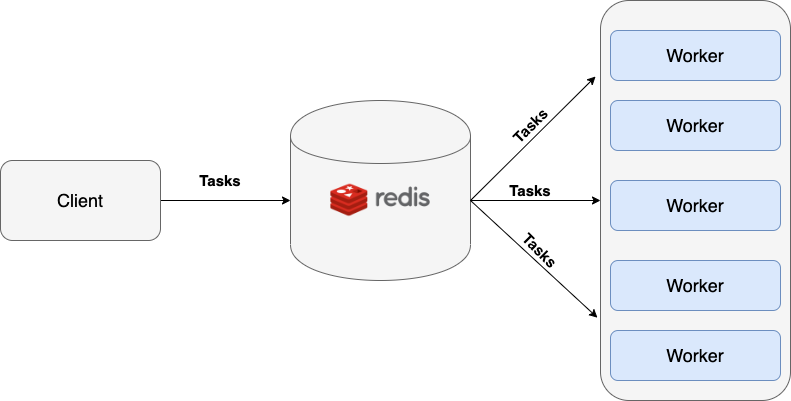7.8 KiB
Asynq
Asynq is a simple Go library for queueing tasks and processing them in the background with workers.
It is backed by Redis and it is designed to have a low barrier to entry. It should be integrated in your web stack easily.
Features
- Guaranteed at least one execution of a task
- Scheduling of tasks
- Durability since tasks are written to Redis
- Retries of failed tasks
- Concurrency management via configuration
- Weighted priority queues
- Strict priority queues
- Low latency to add a task since writes are fast in Redis
- De-duplication of tasks using unique option
- Allow timeout and deadline per task
- Flexible handler interface with support for middlewares
- CLI to inspect and remote-control queues and tasks
Quickstart
First, make sure you are running a Redis server locally.
$ redis-server
Next, write a package that encapsulates task creation and task handling.
package tasks
import (
"fmt"
"github.com/hibiken/asynq"
)
// A list of background task types.
const (
EmailDelivery = "email:deliver"
ImageProcessing = "image:process"
)
// Write function NewXXXTask to create a task.
func NewEmailDeliveryTask(userID int, tmplID string) *asynq.Task {
payload := map[string]interface{}{"user_id": userID, "template_id": tmplID}
return asynq.NewTask(EmailDelivery, payload)
}
func NewImageProcessingTask(src, dst string) *asynq.Task {
payload := map[string]interface{}{"src": src, "dst": dst}
return asynq.NewTask(ImageProcessing, payload)
}
// Write function HandleXXXTask to handle the given task.
// NOTE: It satisfies the asynq.HandlerFunc interface.
func HandleEmailDeliveryTask(ctx context.Context, t *asynq.Task) error {
userID, err := t.Payload.GetInt("user_id")
if err != nil {
return err
}
tmplID, err := t.Payload.GetString("template_id")
if err != nil {
return err
}
fmt.Printf("Send Email to User: user_id = %d, template_id = %s\n", userID, tmplID)
// Email delivery logic ...
return nil
}
func HandleImageProcessingTask(ctx context.Context, t *asynq.Task) error {
src, err := t.Payload.GetString("src")
if err != nil {
return err
}
dst, err := t.Payload.GetString("dst")
if err != nil {
return err
}
fmt.Printf("Process image: src = %s, dst = %s\n", src, dst)
// Image processing logic ...
return nil
}
In your web application code, import the above package and use Client to enqueue tasks to the task queue.
A task will be processed by a background worker as soon as the task gets enqueued.
Scheduled tasks will be stored in Redis and will be enqueued at the specified time.
package main
import (
"time"
"github.com/hibiken/asynq"
"your/app/package/tasks"
)
const redisAddr = "127.0.0.1:6379"
func main() {
r := &asynq.RedisClientOpt{Addr: redisAddr}
c := asynq.NewClient(r)
// Example 1: Enqueue task to be processed immediately.
t := tasks.NewEmailDeliveryTask(42, "some:template:id")
err := c.Enqueue(t)
if err != nil {
log.Fatal("could not enqueue task: %v", err)
}
// Example 2: Schedule task to be processed in the future.
t = tasks.NewEmailDeliveryTask(42, "other:template:id")
err = c.EnqueueIn(24*time.Hour, t)
if err != nil {
log.Fatal("could not schedule task: %v", err)
}
// Example 3: Pass options to tune task processing behavior.
// Options include MaxRetry, Queue, Timeout, Deadline, etc.
t = tasks.NewImageProcessingTask("some/blobstore/url", "other/blobstore/url")
err = c.Enqueue(t, asynq.MaxRetry(10), asynq.Queue("critical"), asynq.Timeout(time.Minute))
if err != nil {
log.Fatal("could not enqueue task: %v", err)
}
}
Next, create a binary to process these tasks in the background.
To start the background workers, use Background and provide your Handler to process the tasks.
You can optionally use ServeMux to create a handler, just as you would with "net/http" Handler.
package main
import (
"github.com/hibiken/asynq"
"your/app/package/tasks"
)
const redisAddr = "127.0.0.1:6379"
func main() {
r := &asynq.RedisClientOpt{Addr: redisAddr}
bg := asynq.NewBackground(r, &asynq.Config{
// Specify how many concurrent workers to use
Concurrency: 10,
// Optionally specify multiple queues with different priority.
Queues: map[string]int{
"critical": 6,
"default": 3,
"low": 1,
},
// See the godoc for other configuration options
})
// mux maps a type to a handler
mux := asynq.NewServeMux()
mux.HandleFunc(tasks.EmailDelivery, tasks.HandleEmailDeliveryTask)
mux.HandleFunc(tasks.ImageProcessing, tasks.HandleImageProcessingTask)
// ...register other handlers...
bg.Run(mux)
}
For a more detailed walk-through of the library, see our Getting Started Guide.
To Learn more about asynq features and APIs, see our Wiki and godoc.
Command Line Tool
Asynq ships with a command line tool to inspect the state of queues and tasks.
Here's an example of running the stats command.
For details on how to use the tool, refer to the tool's README.
Installation
To install asynq library, run the following command:
go get -u github.com/hibiken/asynq
To install the CLI tool, run the following command:
go get -u github.com/hibiken/asynq/tools/asynqmon
Requirements
| Dependency | Version |
|---|---|
| Redis | v2.8+ |
| Go | v1.13+ |
Stability and Compatibility
Important Note: Current major version is zero (v0.x.x) to accomodate rapid development and fast iteration while getting early feedback from users. The public API could change without a major version update before v1.0.0 release.
The library is getting close to a stable release, and we are trying to minimize breaking API changes. However, we cannot make any guarantees at this time.
Contributing
We are open to, and grateful for, any contributions (Github issues/pull-requests, feedback on Gitter channel, etc) made by the community. Please see the Contribution Guide before contributing.
Acknowledgements
- Sidekiq : Many of the design ideas are taken from sidekiq and its Web UI
- RQ : Client APIs are inspired by rq library.
- Cobra : Asynqmon CLI is built with cobra
License
Asynq is released under the MIT license. See LICENSE.


